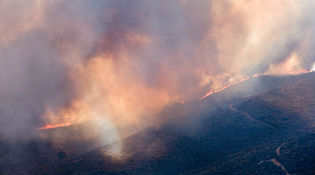 loading
loading
FindingsHold your breathWildfires are multiplying. So is their deadly smoke.  FEMA Photo LibraryThe 2007 Harris fire near San Diego. View full imageIn the summer of 2010, acrid clouds of wildfire smoke blanketed Moscow and, paired with record heat, doubled the city’s mortality rate. Morgue refrigerators hit capacity. Former president Dmitry Medvedev labeled the situation “monstrous.” It is well known that wildfire smoke is associated with acute and chronic respiratory problems, and that climate change is likely to lengthen and intensify wildfire seasons. But precisely how a changing climate might expose specific populations to smoke is not well understood. Jia Coco Liu ’16PhD clarified this interaction through the careful integration of climate, wildfire, population, and smoke dispersion models. Her analysis focused on the western United States and provides unprecedented spatial clarity by mapping shifting wildfire patterns down to the level of individual counties—561 counties in all. After running her model with relatively conservative constraints, Liu and her coauthors found that the number of counties exposed to episodes of heavy smoke pollution is likely to jump more than 400 percent, from 22 today to 97 in about three decades. All told, by 2050 “about 82 million people in the western US are likely to be affected by air pollution from wildfires,” says Liu—with populations across northern California, western Oregon, and the Great Plains hit particularly hard. (Click here for an interactive map.) Liu hopes the findings will spur policymakers to address the growing health threat of wildfire, particularly among vulnerable populations. By studying trends in population growth within the 561 counties, Liu found that 7 million more children and 5.7 million more elderly people will be affected by smoke in mid-century.
The comment period has expired.
|
|